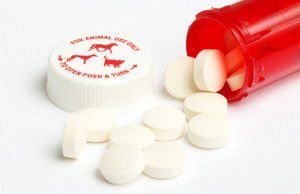Acetaminophen Toxicity in Dogs
websitebuilder • May 27, 2019

I have heard that acetaminophen is toxic to dogs. This is such a common medication. Is this true?
Acetaminophen is a medication that is used to treat fever and/or pain in humans. Unfortunately, acetaminophen toxicity in dogs is somewhat common as dog owners attempt to treat their dogs for pain without first consulting with a veterinarian. Young and small dogs face a greater risk from a single dose of acetaminophen given to them mistakenly by their owners.
What are the signs of acetaminophen toxicity in dogs?
Signs of toxicity from acetaminophen may develop within 1–4 hours of ingestion. These dogs will experience a progressive depression, and they may develop rapid breathing. They may experience abdominal pain and nausea, causing drooling. Their mucus membranes- for instance the gums or the tissue surrounding the globe of the eye- may develop a bluish discoloration. This is called “cyanosis” and is the result of a molecule called “methemoglobin” that interrupts the ability of the red blood cell to carry oxygen to the tissues of the body.
Some dogs will develop fluid buildup in the face, paws, and forelimbs several hours after ingesting acetaminophen. Their urine may become dark or even chocolate-colored from the presence of blood or methemoglobin. Occasionally, the first sign of acetaminophen toxicity is death.
Is there any treatment for a dog who is experiencing acetaminophen toxicity?
The presence of methemoglobin in the blood demands a prompt diagnosis, hospitalization, and aggressive care. Likewise, dark or bloody urine, or yellowish discoloration of the skin or mucus membranes (jaundice) demands inpatient care. These dogs need very gentle handling, as they are often fragile.
Depending upon the timing of the acetaminophen ingestion, the veterinarian may induce vomiting, and may perform flushing of the stomach. This is only useful within 4–6 hours of ingestion of acetaminophen. A low red blood cell count, called “anemia”, blood in the urine, called “hematuria”, or the presence of hemoglobin in the urine, called “hemoglobinuria”, may require a blood transfusion. In addition, intravenous fluid therapy is delivered to maintain proper hydration and electrolyte balance.
Activated charcoal may be administered immediately after vomiting has been induced or after the stomach has been flushed, once vomiting is controlled. The activated charcoal attracts the remaining molecules of acetaminophen and keeps them from being absorbed by the gastrointestinal tract. A medicine called N-acetylcysteine (Mucomyst®) is considered to be an antidote for acetaminophen toxicity. Vitamin C (ascorbic acid) reduces methemoglobin levels in the blood over time.
Once a dog is treated for acetaminophen toxicity, is there any follow-up that must be done?
Blood levels of methemoglobin must be monitored. In addition, levels of serum liver enzymes are monitored in order to assess for liver damage. The level of a compound called glutathione in the blood helps to assess the effectiveness of treatment. Liver damage and the resulting scarring may compromise long-term liver function in dogs who have recovered from acetaminophen toxicity.
If methemoglobin levels in the blood progress rapidly, this is a serious clinical sign, and if the methemoglobin concentration reaches above 50%, the prognosis is grave. Likewise, if the serum liver enzymes continue to rise 12 – 24 hours post-ingestion, then this also raises serious concerns. While clinical signs of acetaminophen toxicity may persist for 12 – 48 hours, death from methemoglobin in the blood can occur at any time. Prompt treatment to reverse methemoglobin in the blood and to prevent liver damage raises the probability of recovery. Unfortunately, death from liver damage may occur in only a few days.
The most important treatment for acetaminophen toxicity is to avoid it!
This client information sheet is based on material written by: Robin Downing, DVM, DAAPM, DACVSMR, CVPP, CRPP
© Copyright 2016 LifeLearn Inc. Used and/or modified with permission under license.

Acetazolamide (brand names: Diamox®) is a diuretic and antiglaucoma agent, used primarily to treat glaucoma (increased eye pressure), syringomyelia (cyst that affects nervous system), and metabolic alkalosis. Its use in cats and dogs to treat glaucoma, syringomyelia, or metabolic alkalosis is ' off label ' or ' extra label '. Many drugs are commonly prescribed for off label use in veterinary medicine. In these instances, follow your veterinarian’s directions and cautions very carefully as their directions may be significantly different from those on the label.


